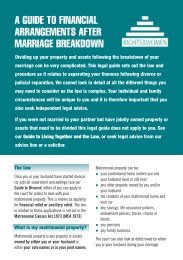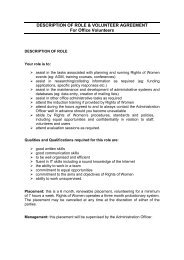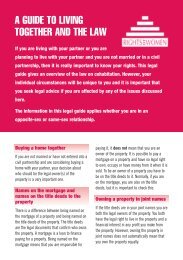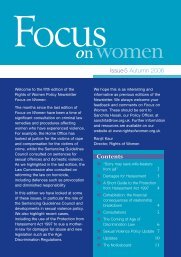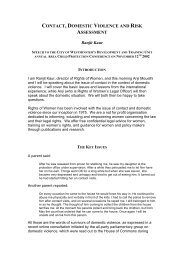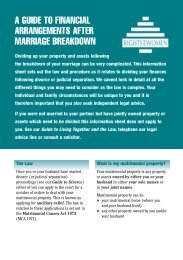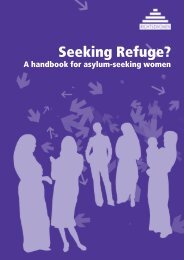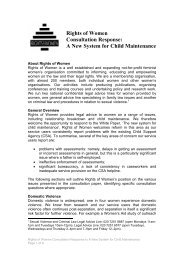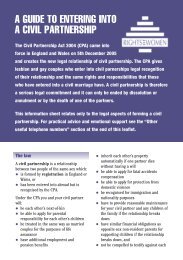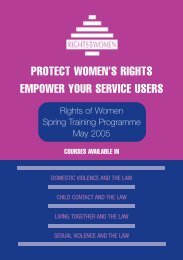domestic violence -pn2415 - Rights of Women
domestic violence -pn2415 - Rights of Women
domestic violence -pn2415 - Rights of Women
You also want an ePaper? Increase the reach of your titles
YUMPU automatically turns print PDFs into web optimized ePapers that Google loves.
● are or were engaged to be married or<br />
agreed to enter into a civil partnership;<br />
● are or were living in the same<br />
household (this includes flat mates);<br />
● are relatives (this includes half blood<br />
and step relatives, people who would be<br />
in-laws if you were married or in a civil<br />
partnership and now includes first<br />
cousins);<br />
● are parents <strong>of</strong> the same child or<br />
involved in the same family court case.<br />
The DVCVA will also create a new<br />
category <strong>of</strong>:<br />
● are or were involved in an intimate<br />
relationship <strong>of</strong> significant duration.<br />
Seek legal advice to find out whether this<br />
has become law and applies to you.<br />
Before making your application we<br />
would strongly advise that you check<br />
whether you are legally ‘associated’ to<br />
your abuser. If you are not, you may be<br />
able to apply for a different kind <strong>of</strong><br />
injunction under different legislation<br />
such as the PFHA.<br />
A non-molestation order will protect<br />
you from <strong>violence</strong> or harassment. Your<br />
abuser does not have to have been<br />
physically violent towards you. It can:<br />
● forbid your abuser from being violent<br />
towards you or any children in your<br />
family, from threatening <strong>violence</strong> or<br />
from harassing, pestering or<br />
intimidating you in many different<br />
ways;<br />
● stop him from coming within a certain<br />
distance <strong>of</strong> your home;<br />
● forbid him from damaging or disposing<br />
<strong>of</strong> your belongings.<br />
You can apply for a non-molestation order<br />
even if you want to continue living with<br />
him.<br />
When deciding whether to grant a nonmolestation<br />
order the court will consider<br />
all <strong>of</strong> your circumstances, including the<br />
need to secure the health, safety and well<br />
being <strong>of</strong> you and any children. You<br />
therefore need to show the court how your<br />
health, safety or well-being or that <strong>of</strong> your<br />
children is at risk if you are not granted<br />
the order.<br />
An occupation order deals with who<br />
lives in your home. There are different<br />
types <strong>of</strong> order that the court can make. It<br />
can:<br />
● order your abuser to move out <strong>of</strong> the<br />
home or to stay away from the home;<br />
● order him to stay a certain distance<br />
away from the home;<br />
● order him to stay in certain parts <strong>of</strong><br />
your home;<br />
● order him to allow you back into the<br />
home if he has locked you out;<br />
● order him to pay the mortgage, rent or<br />
bills for the home;<br />
● order him not to damage or destroy the<br />
home.<br />
The type <strong>of</strong> occupation order you can<br />
apply for depends on whether you or<br />
your abuser are legally entitled to<br />
occupy the property and on the type <strong>of</strong><br />
relationship you have. Before making<br />
your application we would strongly<br />
advise you to seek legal advice.<br />
To decide whether to grant an occupation<br />
order the court will consider things like the<br />
housing needs and resources <strong>of</strong> you, your



